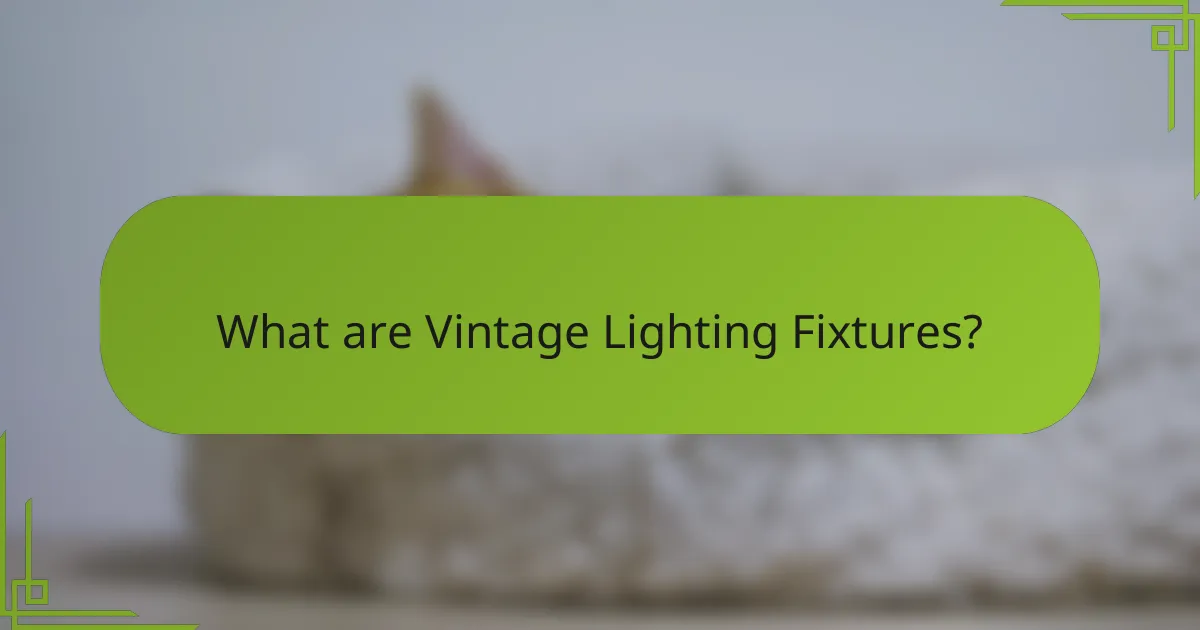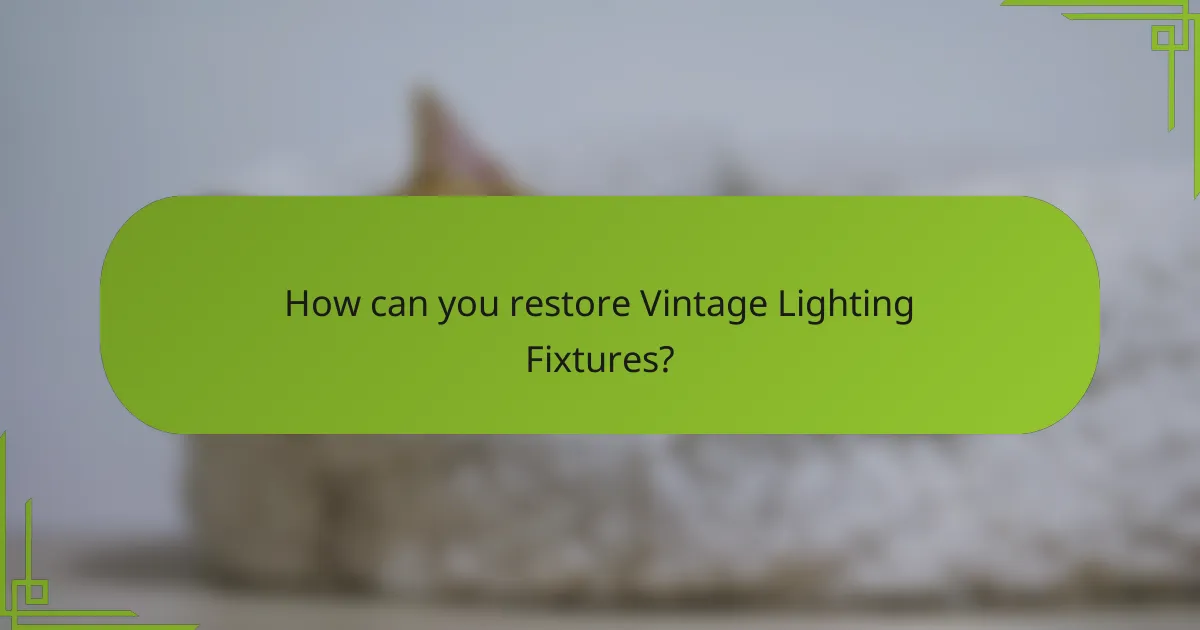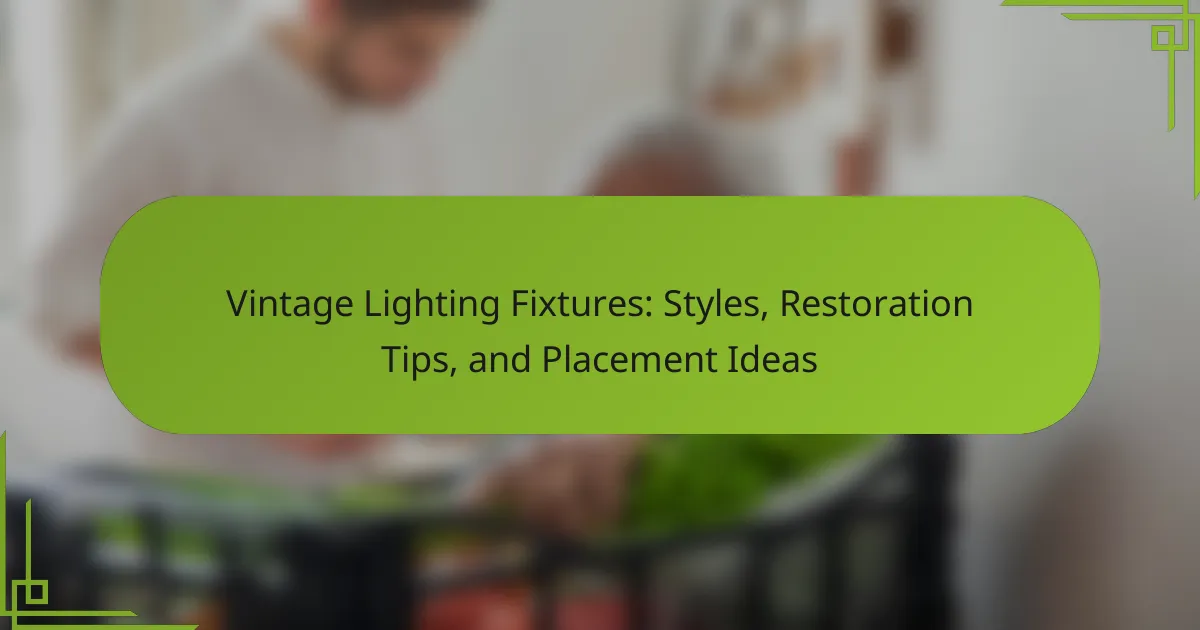
What are Vintage Lighting Fixtures?
Vintage lighting fixtures are decorative light sources that originate from earlier design periods, typically from the 20th century or earlier. These fixtures often feature unique designs, materials, and craftsmanship that reflect the aesthetics of their time. Common styles include Art Deco, Mid-Century Modern, and Victorian. Vintage fixtures can be made from materials such as brass, glass, and wrought iron. They are sought after for their character and ability to enhance interior decor. The historical significance of these fixtures adds to their appeal, making them popular among collectors and interior designers.
How do Vintage Lighting Fixtures differ from modern options?
Vintage lighting fixtures differ from modern options primarily in design and materials. Vintage fixtures often feature intricate designs and craftsmanship. They may incorporate materials like brass, glass, and ceramic. In contrast, modern fixtures tend to favor minimalism and functionality. They frequently use materials such as plastic and metal. Vintage lighting often has a warm, nostalgic aesthetic. Modern designs typically emphasize sleek lines and contemporary styles. Additionally, vintage fixtures may include unique historical elements. Modern options often prioritize energy efficiency and smart technology. These differences highlight the distinct characteristics of each style.
What defining characteristics make a lighting fixture ‘vintage’?
A lighting fixture is considered ‘vintage’ if it reflects a design style from a previous era. Common characteristics include the use of materials like brass, glass, or wrought iron. Vintage fixtures often feature intricate detailing and craftsmanship. They may exhibit patina or signs of wear that add to their charm. Popular vintage styles include Art Deco, Mid-Century Modern, and Victorian. These styles often incorporate unique shapes and colors not commonly found in contemporary designs. Vintage lighting fixtures are typically sourced from estate sales, antique shops, or auctions. Their age and historical significance contribute to their appeal and value in the market.
How do historical periods influence vintage lighting styles?
Historical periods significantly influence vintage lighting styles through design trends, materials, and technological advancements. Each era reflects the cultural values and aesthetics of its time. For instance, the Victorian era emphasized ornate designs and intricate details, using materials like brass and glass. The Art Deco period introduced geometric shapes and vibrant colors, showcasing new manufacturing techniques. Mid-century modern lighting focused on minimalism and functionality, often utilizing materials like plastic and metal. These shifts in style correspond to broader societal changes, such as industrialization and modernism. Thus, vintage lighting styles serve as a visual representation of historical context and innovation.
What types of Vintage Lighting Fixtures are available?
Vintage lighting fixtures are available in several distinct types. These include chandeliers, pendant lights, sconces, and table lamps. Chandeliers often feature intricate designs and multiple bulbs. Pendant lights hang from the ceiling and can vary in size and style. Sconces are wall-mounted fixtures that provide ambient light. Table lamps are versatile and can complement various decor styles. Each type reflects unique historical design elements, often from specific eras such as Art Deco or Mid-Century Modern. Vintage lighting fixtures can enhance the aesthetic of both residential and commercial spaces.
What are the most popular styles of vintage lighting fixtures?
The most popular styles of vintage lighting fixtures include Art Deco, Mid-Century Modern, Industrial, and Victorian. Art Deco fixtures are characterized by bold geometric shapes and rich materials. Mid-Century Modern lighting features clean lines and organic forms. Industrial lighting often incorporates metal and utilitarian designs, reflecting a raw aesthetic. Victorian fixtures are known for their ornate details and intricate craftsmanship. These styles have remained popular due to their unique aesthetics and historical significance in interior design.
How do materials used in vintage lighting affect their appeal?
Materials used in vintage lighting significantly enhance their appeal. Various materials, such as brass, glass, and ceramic, contribute to the aesthetic and historical value of these fixtures. Brass offers a warm, classic look that ages beautifully over time. Glass shades can create unique light patterns and add elegance. Ceramic elements often feature intricate designs, showcasing craftsmanship from specific eras. The combination of these materials can evoke nostalgia and connect users to the past. Additionally, the rarity of certain materials can increase desirability among collectors. Overall, the choice of material directly influences both the visual and emotional connection to vintage lighting.
What are the benefits of incorporating Vintage Lighting Fixtures into your space?
Incorporating vintage lighting fixtures into your space enhances aesthetics and adds character. These fixtures often feature unique designs that reflect historical craftsmanship. They can serve as focal points, drawing attention and sparking conversation. Vintage lighting also provides a warm ambiance, creating a cozy atmosphere. Many vintage fixtures are made from durable materials, ensuring longevity. They can complement various interior styles, from rustic to modern. Additionally, using vintage lighting promotes sustainability by reusing existing materials. Overall, vintage lighting fixtures enrich spaces both visually and environmentally.
How do vintage fixtures enhance the aesthetic of a room?
Vintage fixtures enhance the aesthetic of a room by adding character and charm. They often showcase unique designs that reflect historical craftsmanship. Such fixtures can serve as focal points, drawing attention and sparking conversations. Vintage lighting creates a warm ambiance that modern fixtures may lack. The materials used in vintage fixtures, like brass or glass, contribute to a timeless appeal. Incorporating these elements can elevate a room’s overall design. Research indicates that vintage decor can increase perceived value and warmth in interior spaces. This aesthetic appeal is rooted in nostalgia and a connection to history.
What unique ambiance do vintage lighting fixtures create?
Vintage lighting fixtures create a warm and nostalgic ambiance. This ambiance is characterized by a soft glow that enhances the aesthetic of any space. The use of materials like glass, brass, and wrought iron contributes to a classic feel. Vintage fixtures often feature unique designs that evoke a sense of history. This can make a room feel more inviting and intimate. Additionally, the varied styles can complement both modern and traditional decor. The presence of vintage lighting can also spark conversation and interest among guests. Overall, vintage lighting fixtures transform spaces into cozy, character-rich environments.

How can you restore Vintage Lighting Fixtures?
To restore vintage lighting fixtures, first, clean all components thoroughly. Use a soft cloth and mild soap to remove dust and grime. Next, inspect the wiring for any damage. Replace frayed or broken wires to ensure safety. Then, polish metal surfaces with appropriate cleaners to restore shine. If the fixture has glass elements, carefully clean them with a glass cleaner. Reassemble the fixture after all parts are cleaned and repaired. Finally, install new bulbs that match the original style for an authentic look. This process preserves the fixture’s historical value while ensuring functionality.
What common issues arise with vintage lighting fixtures?
Common issues with vintage lighting fixtures include electrical problems, wear and tear, and difficulty finding replacement parts. Electrical issues often arise from outdated wiring or faulty connections. Wear and tear can manifest as rust, corrosion, or damage to the finish. Additionally, finding compatible bulbs can be challenging due to obsolete socket types. These factors can complicate the restoration process and affect functionality. Regular maintenance is essential to mitigate these issues.
How can you identify electrical problems in vintage fixtures?
To identify electrical problems in vintage fixtures, start by inspecting for visible signs of wear. Look for frayed wires, loose connections, or burn marks. These issues indicate potential electrical hazards. Next, test the fixture with a multimeter to check for continuity and voltage. A lack of voltage suggests a wiring issue. Additionally, listen for unusual buzzing or flickering lights during operation. These symptoms often signal underlying electrical problems. Lastly, consult a professional electrician if you notice persistent issues. They can provide a thorough assessment and ensure safety.
What steps should be taken to clean and polish vintage lighting?
To clean and polish vintage lighting, start by turning off and unplugging the fixture. Remove any bulbs and shades carefully. Dust the fixture with a soft, dry cloth to eliminate surface dirt. For deeper cleaning, use a damp cloth with mild soap, avoiding harsh chemicals. Rinse with a clean, damp cloth to remove soap residue. Dry the fixture thoroughly to prevent moisture damage. For polishing, apply a metal polish suitable for the fixture’s material. Buff the surface with a soft cloth until shiny. Regular maintenance helps preserve the vintage lighting’s appearance and functionality.
What tools and materials are needed for restoration?
Restoration of vintage lighting fixtures requires specific tools and materials. Essential tools include screwdrivers, pliers, and wire strippers. A soldering iron is necessary for electrical connections. Safety goggles protect eyes during the process. Materials needed comprise replacement bulbs, wiring, and sockets. Electrical tape ensures secure connections. Paint or polish may be required for aesthetic restoration. Additionally, cleaning solutions help remove grime and restore shine. These tools and materials are standard for effective restoration of vintage lighting fixtures.
Which cleaning agents are safe for vintage lighting fixtures?
Mild soap and water are safe cleaning agents for vintage lighting fixtures. These agents effectively remove dust and grime without damaging delicate surfaces. Avoid harsh chemicals that can cause discoloration or corrosion. Vinegar diluted with water is also safe for cleaning metal fixtures. It can help remove tarnish without causing harm. For glass components, a gentle glass cleaner is appropriate. Always test any cleaning agent on a small, inconspicuous area first. This ensures that it does not react negatively with the finish or material.
What tools are essential for minor repairs?
Essential tools for minor repairs include a screwdriver set, pliers, a hammer, and a utility knife. A screwdriver set is crucial for tightening or loosening screws in fixtures. Pliers assist in gripping and bending wires or small components. A hammer is useful for tapping fixtures into place or removing nails. A utility knife helps in cutting through insulation or other materials. These tools are commonly found in most households and are effective for basic repair tasks.
How can you ensure safety while restoring vintage lighting?
To ensure safety while restoring vintage lighting, always disconnect the power supply first. This prevents electrical shock during the restoration process. Use insulated tools to further minimize the risk of electric shock. Inspect the wiring for any fraying or damage. Replace any compromised wires with modern equivalents that meet current safety standards. When working with glass components, wear safety goggles to protect your eyes from breakage. Always follow manufacturer guidelines for restoration and replacement parts. Historical data shows that improper restoration can lead to fire hazards. Adhering to these safety measures significantly reduces risks associated with vintage lighting restoration.
What precautions should be taken when working with electrical components?
When working with electrical components, it is essential to ensure safety. Always disconnect power before handling any components. Use insulated tools to prevent electric shock. Wear rubber-soled shoes and avoid working in wet conditions. Check for damaged wires and components before use. Follow manufacturer guidelines for installation and maintenance. Use circuit testers to verify power is off. Keep work areas dry and clutter-free to avoid accidents. These precautions help prevent injuries and ensure safe handling of electrical components.
How can you verify that the restored fixture is safe for use?
To verify that the restored fixture is safe for use, conduct a thorough inspection of its electrical components. Check for frayed wires, loose connections, and signs of corrosion. Ensure that all light bulbs are compatible with the fixture’s specifications. Test the fixture with a multimeter to check for proper voltage and grounding. Inspect the fixture for any structural damage or instability. Finally, consider consulting a licensed electrician for a professional assessment. According to the National Electrical Code, fixtures must meet specific safety standards to be deemed safe for use.

Where should you place Vintage Lighting Fixtures in your home?
Place vintage lighting fixtures in areas where they can enhance the aesthetic and functionality of your home. Common locations include entryways, dining rooms, and living rooms. In entryways, they create an inviting atmosphere for guests. Dining rooms benefit from vintage fixtures as they add elegance during meals. Living rooms can showcase vintage lighting as a focal point, complementing the decor. Consider placing them above tables or in corners to maximize their impact. Vintage fixtures can also be used in bedrooms for a cozy ambiance. Proper placement highlights their unique design and craftsmanship.
What factors should be considered when choosing a placement for vintage fixtures?
When choosing a placement for vintage fixtures, consider the room’s overall design and function. The style of the fixture should complement the existing decor. Placement height is crucial for optimal lighting and aesthetic appeal. Ensure fixtures are positioned to avoid obstruction and maximize their visual impact. Proximity to power sources is also important for installation convenience. Consider the size of the room; larger fixtures may overwhelm small spaces. The fixture’s intended purpose, such as ambient or task lighting, should guide placement decisions. Lastly, consider the flow of movement within the space to prevent crowding.
How does room size affect the placement of vintage lighting?
Room size significantly impacts the placement of vintage lighting. In smaller rooms, vintage lighting should be placed to maximize space and avoid overwhelming the area. Fixtures like wall sconces can provide illumination without taking up floor space. In larger rooms, vintage chandeliers or pendant lights can serve as focal points. These fixtures can be hung lower to create intimacy or higher for a dramatic effect. Additionally, in expansive spaces, multiple light sources may be necessary to ensure even lighting. Proper placement enhances both functionality and aesthetic appeal.
What role does the style of the room play in fixture placement?
The style of the room significantly influences fixture placement. Different styles dictate the aesthetic and functional requirements of lighting. For example, a vintage room often requires fixtures that complement its historical design. The placement should enhance the room’s character and not disrupt the overall theme. Fixtures should align with the room’s color palette and materials. In a modern space, minimalist fixtures may be preferred for a clean look. Proper placement ensures that fixtures provide adequate illumination while maintaining visual harmony. This approach maximizes the impact of the lighting on the room’s ambiance.
What are some creative placement ideas for vintage lighting fixtures?
Vintage lighting fixtures can be creatively placed in various settings to enhance décor. Hang them over dining tables for a focal point. Use them in entryways to create an inviting atmosphere. Install vintage sconces in hallways for added character. Place a vintage lamp on a bedside table for a cozy feel. Incorporate them into a gallery wall for artistic flair. Utilize pendant lights in kitchens to blend style with functionality. Position them in reading nooks to provide warm illumination. Each placement idea leverages the unique charm of vintage fixtures, making them versatile in different environments.
How can vintage fixtures be used to highlight architectural features?
Vintage fixtures can accentuate architectural features by drawing attention to unique design elements. They can enhance the character of a space, emphasizing details such as moldings, arches, or ceiling heights. For instance, a vintage chandelier can highlight a grand foyer’s height and elegance. Wall sconces can illuminate textured surfaces, such as brick or wood paneling, adding depth. Pendant lights can showcase kitchen islands or dining areas, creating focal points. The style of vintage fixtures often complements historical architecture, reinforcing the overall aesthetic. Using these fixtures strategically can create a cohesive design that celebrates the building’s heritage.
What are some unconventional spaces where vintage lighting can be effective?
Vintage lighting can be effective in unconventional spaces such as bathrooms, laundry rooms, and outdoor patios. In bathrooms, vintage fixtures can add a touch of elegance and charm. Laundry rooms benefit from vintage lighting by creating a warm, inviting atmosphere. Outdoor patios can be enhanced with vintage string lights or lanterns, providing a cozy ambiance for gatherings. Additionally, vintage lighting works well in home offices, adding character and a unique aesthetic. These spaces often lack traditional lighting styles, making vintage options stand out. The use of vintage lighting in these areas can transform their overall appeal and functionality.
What tips can enhance the effectiveness of Vintage Lighting Fixtures?
Choose the right bulb for vintage lighting fixtures. LED bulbs mimic the warm glow of incandescent bulbs. Ensure proper wattage to avoid overheating. Clean fixtures regularly to maintain brightness and aesthetic appeal. Use dimmer switches for adjustable ambiance. Position fixtures to highlight architectural features or artwork. Layer lighting with additional sources for depth. Consider the fixture’s style and era for cohesive decor.
How can you layer lighting with vintage fixtures for optimal effect?
Layering lighting with vintage fixtures involves combining different types of light sources to create a balanced ambiance. Start with ambient lighting for overall illumination. Use vintage chandeliers or ceiling fixtures to achieve this effect. Next, incorporate task lighting for specific activities. Vintage table lamps or wall sconces can serve this purpose effectively. Finally, add accent lighting to highlight decor or architectural features. Vintage picture lights or spotlights are ideal for this task. This layered approach enhances the aesthetic appeal and functionality of a space while showcasing the unique characteristics of vintage fixtures.
What maintenance practices will keep vintage lighting looking its best?
Regular cleaning is essential to maintain vintage lighting. Use a soft, dry cloth to dust fixtures weekly. For deeper cleaning, mix mild soap with water. Avoid harsh chemicals that can damage finishes. Inspect wiring and bulbs periodically for safety. Replace burnt-out bulbs promptly to avoid further damage. Store unused fixtures in a dry, cool place to prevent deterioration. Proper maintenance extends the life and appearance of vintage lighting.
Vintage lighting fixtures are decorative light sources from earlier design periods, characterized by unique designs and materials such as brass, glass, and wrought iron. This article explores various vintage styles, including Art Deco and Mid-Century Modern, and provides insights on how to differentiate them from modern options. It also covers the restoration process, common issues, and essential safety precautions for vintage fixtures. Additionally, the article offers guidance on optimal placement within different spaces and creative ideas for enhancing interior aesthetics using vintage lighting.
